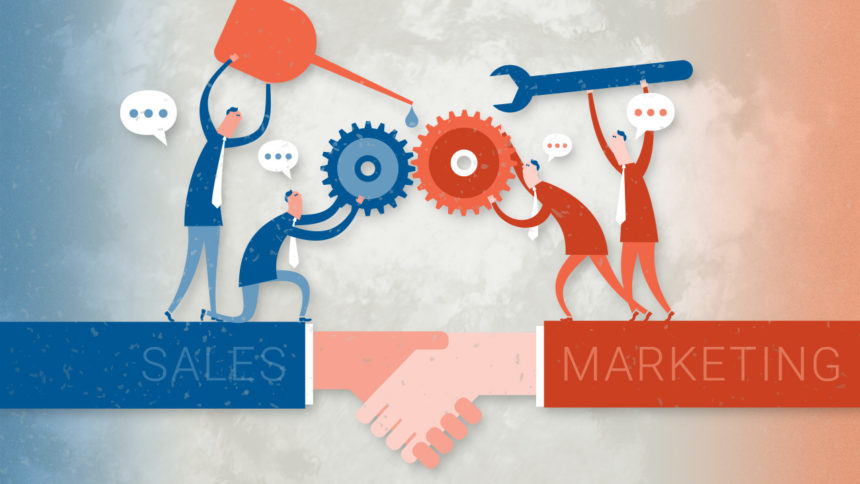When a sales team becomes frustrated with marketing the frustrations is most frequently rooted in poor lead quality. It is an understandable frustration, after all the job of a sales representative is literally the only job in the entire company that is expected to shoulder a fair amount of risk. Failure in another role might stifle career growth, or limit internal opportunities, but failure in the sales role leads to dramatically less compensation. So when an organization in the company, marketing, is seemingly not fulfilling its promise of an easier path to closing deals, the frustration levels of the benefactors of the promise, sales, rise.
Ironically marketing might have a fair degree of frustration with the sales team, frustrations most frequently built atop two complaints. One, the sales team is chasing opportunities that are not a good fit and don’t line up to the well thought out positioning. Two, the sales team is unsatisfied with any lead that requires even the littlest bit of effort to move the prospect into the sales process.
It is an age old necessary tension that has existed since the beginning of business time. A reality that I learned early in my career when I picked up a book on my boss’s desk. The cover screamed in big bold font “EVERYTHING SALES KNOWS ABOUT MARKETING.” Inside the book all of the pages were blank. Funny enough, right? But flip the book over and the back cover screamed equally as loud “EVERYTHING MARKETING KNOWS ABOUT SALES.”
The joke is obvious of course, but the sentiment is absolutely important. Marketing and sales are two distinct disciplines. When marketing and sales are completely aligned the results are good. When they are not tension rise, targets are missed, and sales representatives earn less. So the question becomes what can sales professionals do that will foster a greater and more fruitful marketing and sales alliance?
Make expectations clear.
Simple enough to communicate expectations, after all marketing serves sales does it not? But the key in a successful and improved marketing sales alliance is that the communication of expectations must be a two sided conversation. Not a list of demands that, if not met, will be fodder for the justified slander of the marketing team. But an intelligent examination of what rests behind each expectation. And a willingness to consider these expectations anew from the perspective of a partner that has different but valuable experience.
If marketing and sales relationships are strained it may very well be due to the fact that expectations are not defined with detail, but left one-dimensional declarative statements. Statements that reference lead quality without describing the nature of what acceptable quality might be. Or something about volume of demand that may or may not be connected to quality. The expectations are fair but unclear. It reminds me again of that boss that had the book of sales and marketing knowledge on his desk. He would frequently say that defining something as ‘big’ wasn’t good enough. Big in comparison to what? ‘Big’ needed clear parameters, reference points, and examples. This is the same sort of detail that sales needs to consider when communicating their expectations.
For instance let’s consider lead quality. Perhaps the most informative piece of information that sales can share with marketing about lead quality is the details of the early part of the sales process. This is difficult because as most sales professionals know the early stages of the process are murky. The opportunity is unclear. It is a more nuanced and creative exercise to engage a prospect early in the cycle simply to get them to the next stage and closer to an identified opportunity.
It is critical for marketing to understand the gyrations that the sales rep goes through in these early stages. The level of effort required to get the prospect to the next stage. The frustration that the rep feels when they have spent a good deal of time nurturing the prospect only to realize a month later that there is most likely no opportunity to be had. It is important because no matter how awesome the lead quality is that is coming from marketing the sales rep still has work to do to move them from that early stage to the next. That work happens on good leads and bad leads. If a sales rep is going to accept a marketing qualified lead, the expectation is that the effort to move the prospect forward will be easier than a lead that they unearthed themselves.
That is the key. The effort cannot be equal to the effort of their own prospecting, it has to be lower.
This is exactly where the conversation around the expectation of quality can finally get productive and turn away from the esoteric ‘quality’ towards the specific things a rep does to push a prospect deeper into his sales process.
- What specific exchange between prospect and sales rep helps determine whether or not the opportunity is real?
- What questions from the prospect are tell-tale signs that their status quo is not good enough?
- What part of our solution story is most likely to get them talking more?
- What key piece of knowledge do we have that the prospect doesn’t have?
- What anecdote can we share that will help the prospect see themselves in our offering?
- What are the disqualifying inquires and questions that typically indicate that the fit is incorrect even if the opportunity is real?
This is all nuanced and learned wisdom that good sales reps take for granted. But guess what? It is more likely than not that the marketing team simply does not have that wisdom. So it has to be shared with them. And when that nuance is shared the sales team will be blown away by the level of support that they’ll get from their marketing peers. The sales team will suddenly see how specific pieces of content and sales tools can be better leveraged to wrestle prospects through those early stages in a more efficient and expedient manner.
The necessary tension that exists between sales and marketing can be frustrating. Sales leadership can take ownership of its side of the conversation and mitigate the frustration by committing to serving their marketing brethren by sharing more details around the nuance of the sales process.








